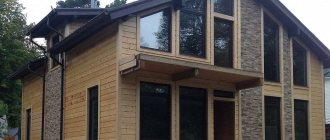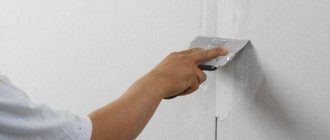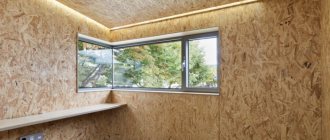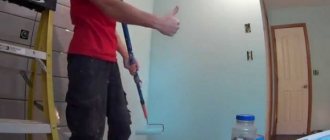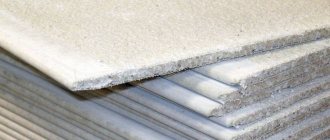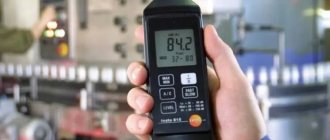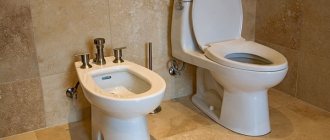Hi all! Today I want to talk about such a material as external drywall. Recently a friend asked me if it was possible to sheathe a façade with it. I said that aqua panels would be more reliable, and that drywall, even moisture-resistant, should not be used for exterior decoration. It copes with humidity, but only in buildings and rooms. If you still bought drywall, then make the facade in 2 layers, and treat the joints with silicone-based putty. It is also possible to increase resistance to moisture by painting. But you also need to buy silicone-based paint. Let's take a closer look at how to carry out all the steps of the process.
What is the difference between external drywall and regular drywall?
Special sheets are used to decorate the façade of a house with plasterboard. They are treated with hydrophobic impregnation. GCR has the following properties:
- energy saving - heat remains in the house, cold does not enter the room;
- moisture resistance – this drywall does not allow moisture to pass through. Fungus and mold do not appear on the interior walls of the room;
- sound insulation – noise from the street is practically inaudible in the house;
- façade plasterboard does not deform under the influence of weather conditions.
On the practical side, there are the following properties:
- the smooth surface of the plasterboard makes the facade beautiful and attractive;
- there are a lot of finishing options;
- working with plasterboard does not take much time;
- the insulation laid between the walls and drywall is not exposed to external influences of temperature and moisture;
- façade plasterboard is safe for people and the environment;
- at low temperatures, drywall does not deform or burst.
With all the positive properties there are some disadvantages:
- The facade of the house cannot be covered with any other type of plasterboard, except for façade gypsum plasterboard.
- If drywall is constantly exposed to water, it will become deformed.
- If the drywall sheets are constantly exposed to high temperatures, the structure will collapse.
- GCR is fragile and breaks easily, so work should be carried out carefully and carefully.
When a set of deficiencies occurs, it is necessary to handle the gypsum board accordingly.
Which substitute should I choose?
Whenever choosing an analogue of drywall, you need to take into account the place of its use. Some materials, as we see, can be successfully used for exterior work, where gypsum boards are almost never used, some can become a replacement for finishing interior walls and ceilings. Before replacing drywall, you need to carefully calculate not only the financial component, but also further operational adaptability. After all, both in terms of labor costs and the price of the material itself, gypsum boards remain uncompetitive. On the other hand, some of the listed materials have properties that can significantly save on the final result.
For example, having a beautiful glossy surface, PVC panels will allow you to save on putty, painting or wallpapering. And this is definitely a plus. But, if you need to make changes to the design of the room, then this quality will become a minus. And even with minor damage, to eliminate it, you will have to dismantle and then reinstall a significant amount of finishing material, and replace the entire panel, the cost of which will increase the already expensive work. Whereas repairing drywall is always very simple and much more affordable. The market does not stand still, new production lines are opening, energy-saving technologies are being applied. All this allows us to develop more and more new materials that can either replace each other or perfectly complement each other.
Which profile to use when sheathing a house with plasterboard on the outside
To prevent the profile from rusting, use an aluminum type.
For exterior finishing, use a special aluminum profile coated with an anti-corrosion compound. It is produced by pressing. There is a profile of normal and increased strength.
Properties of aluminum profile:
- The weight is light.
- Durability – able to withstand a certain weight.
- Rigidity – does not bend during installation and operation.
- Aluminum profiles are available in different sizes.
- The frame made of profile lasts a long time.
- Using this profile it is possible to manufacture curved structures.
- Working with this building material is simple and easy.
- Aluminum profiles do not contain toxic substances and are therefore safe for health.
When creating a frame from a facade profile, it should be taken into account that the fasteners must be treated with an anti-corrosion compound. After installation, the space should be filled with thermal insulation material. This is mainly polystyrene foam or construction wool.
If the house is made of natural stone, the frame is not mounted. After fixing the heat-insulating material, the sheets are attached to the wall with special fasteners.
GKLO
Fireproof, marked red (GKLO), it is used mainly in dry places or with high air temperatures. Typically, this type of drywall is recommended to be installed in ventilation shafts, attics, and other places where there is a risk of fire.
It should be noted that thanks to reinforcing additives, such drywall is able to withstand very high temperatures, and possibly even an open flame of fire. The color of the plaster is pink.
Materials for covering a house with external plasterboard
Primer. To treat the surface outside, a soil mixture is used:
- façade primer – anti-corrosion. Prevents rust;
- antiseptic – prevents the appearance and spread of fungus and mold, fights the appearance of beetles and other pests;
- primer with deep penetration - for greater adhesion of building materials;
- hydrophobic composition – prevents the penetration of water and moisture;
- universal primer - has many properties and is widely used in outdoor work
Putty. It has the main task of withstanding temperature changes and alternating high humidity and dryness.
Putty can be of 3 types:
- starting – base;
- finishing – main. With its help, the surface is leveled and prepared for subsequent decoration;
- universal - can be used as a base or finishing finish.
When finishing exteriors, it is important to choose the right plaster.
The qualities that universal putty has: elastic, frost-resistant, durable, breathable, quick-drying, does not contain toxic impurities. This putty is easy to work with and sands well. The composition of putty mixtures is:
- polymer – suitable for outdoor use;
- cement – there is shrinkage;
- polyurethane - universal composition;
- gypsum - not recommended for street work, because does not tolerate moisture well.
With the right choice of building materials, finishing the facade of a house with plasterboard will not be difficult and will not take much time.
How to properly use drywall for exterior use
To create a beautiful individual house facade, you will need to create a metal frame. Elements must be galvanized to prevent rust. Before installing frame parts, you should prepare the surface. The facade must be clean and without hanging finishing materials. If there is a “belly” in the plaster or “fur coat” of the house, it should be removed. It is also necessary to remove the old whitewash. There should be no dust, cobwebs or dirt.
The surface is primed to prevent the occurrence of fungus and pests. After the primer has dried, this process is quick in the open air; markings should be made. Stretch the fishing line and hang plumb lines (to make the surface even). Installation of profiles begins along the perimeter of the wall, do not forget about windows and doors. After fixing the guide profiles, you should work on the vertical posts and horizontal struts. Each mounted element is checked for evenness with a level.
The metal frame should be made under the very roof and with a slight approach to the foundation line. Once the roof is sheathed, the top edge of the plasterboard wall will be hidden. Below, when insulating the foundation, the lower edge of the facade trim is sealed.
After installing the metal profiles, a corrugated wire is laid on top to illuminate the street. The entire surface is insulated with insulating material.
Reconstruction of an old house: arguments in favor
Choosing the option of demolishing a building requires the preparation of appropriate documents, which in itself is expensive. In addition, it entails a lot of costs.
To build a new house you will need:
- Demolition of the old building, followed by removal of construction waste;
- Permission to build a new one, purchasing a project for a new house and other paperwork, accompanied by a waste of money and vital energy;
- Making a foundation, pouring a screed, erecting a box, a roof and other labor-intensive processes;
- Connecting main communications (in this case, it is necessary to very accurately calculate the permissible load on the power cable, determine the correct slope of sewer pipes, etc.);
- Internal lining of all surfaces of rooms.
Reconstruction of an old house
All this work sometimes takes years to complete. And not everyone can afford such a luxury, while repairs can be completed in the shortest possible time and the walls can be covered with high-quality materials, investing significantly less money.
So, for reconstruction we need:
- Cladding the façade;
- Carry out interior finishing;
- If necessary, replace the old roofing material with new one;
- Carry out cosmetic repairs to the walls of the premises.
How to install drywall on exterior surfaces
Drywall is attached to different surfaces:
- Tree (log house).
- Brick walls.
- Concrete walls.
- Cement board.
- Cinder block surface.
Almost any building material from which the house is laid out is made of a metal frame from galvanized profiles. After creating the frame, the strength and evenness of the surface are checked. Sheets can be fastened both longitudinally and transversely. Drywall sheets should be attached first to the corner of the house.
Fastening occurs according to the rules:
- Fasteners must be galvanized or have a special anti-corrosion coating. The hardware is screwed in by hand.
- Self-tapping screws should have a sharp tip and a semicircular head.
- Fasteners are installed every 20 cm.
- The screws should be turned in a level position.
- There are 15 hardware for 1 square meter.
Knowing these rules, attaching drywall to the frame will not be difficult.
GVL or gypsum board: which is better?
Both materials have admirers and opponents. You will have to decide on your own which is better GVL or gypsum board. In this section we will try to compare them according to the most significant parameters. Let's go over the sizes right away. Drywall is produced in a wider range of both sheet sizes and thickness:
- GKL sheet thickness: 6.5 mm, 8 mm, 10 mm, 12.5 mm, 14 mm, 16 mm, 18 mm, 24 mm. The last three are very rare.
- The height of the gypsum board sheet can be from 2000 mm to 4000 mm in increments of 50 mm.
- The width of the gypsum board is 600 mm or 1200 mm.
As you can see, the range is more than wide. Another thing is that there are usually two or three types on sale. But, if you really want to, everything can be found/ordered. Although, it is usually easier (and cheaper) to buy what is available.
GVL is better for the floor
GVL has only two options for gypsum fiber boards: 2500*1200 mm (standard) and 1500*1000 mm (small format). Both options are available in 10mm and 12.5mm thicknesses. All. There are no other standard sizes. There is also GVL for the floor. Its dimensions are 1200*600 mm, thickness 20 mm. It may be chamfered or not.
| GKL | GVL | |
| Cost per square | from 70 rub/sq.m. | from 180 rub/sq. m. |
| Shock loads | crumbles | tolerates it well |
| Bending loads | tolerates well, bends | breaks down |
| Uncover | easy to cut with a utility knife | you need a serious tool with a special disk |
| Installation of fasteners | special screws are easy to tighten | difficult to twist, you need to pre-drill holes or use self-tapping screws |
| Changes in size with increasing humidity/temperature | 1 mm per meter | 0.3 mm per 1 meter |
| Fire resistance | high - G1 | non-flammable - NG |
| Installation on curved surfaces | available | No |
As a result, it is possible to say that gypsum fiber board or gypsum board is better only based specifically on the area of application and operating conditions. In short, here's how you can divide the areas of application:
- GVL for walls and ceilings is better if fire resistance is required or if it is necessary to increase the rigidity of the structure (in frames).
- It is better to put GVL on the floor, since it reacts less to humidity and does not change its properties.
- GCR is indispensable if you need smooth lines or complex multi-tiered structures. A multi-level ceiling, arches, columns, rounded walls and corners are just drywall.
- If you need to achieve good sound insulation of the second floor, it is better to hem the ceiling with gypsum fiber board.
As you understand, there is no way to definitively say which is better than GVL or gypsum board. In some conditions, one material is better for performing one task, while the characteristics of another are more suitable for another.
How to cover external wooden walls with plasterboard
This type of interior work is carried out using the frame method of installing gypsum boards on the walls, and you can choose either a wooden or metal frame. It all depends on the complexity of the design. After installing a frame made of wooden mounting strips or a galvanized metal profile, sheets of drywall are installed on it using standard self-tapping screws.
The advantages of such finishing can be considered the usual list - ideal alignment of the walls, simple and quick installation, the ability to lay communications into the thickness of the wall, elimination of complex preparatory work, relatively low cost of the process, installation by yourself is quite possible.
How to make a plasterboard arch with your own hands
Arched openings are considered quite popular. It is thanks to this material that, with the least amount of labor, it is possible to make an arch of any shape and place it at the required height. At the same time, it will be securely fixed and meet the required parameters.
In this case, a person receives benefits:
- speed of work;
- low labor costs compared to the use of other materials;
- the quality and strength of the resulting arch.
Note. It made it possible to reproduce the aesthetic elements of the Middle Ages in the modern world.
External plasterboard: installation on a brick facade
All that is needed to start work is to choose the method of installing drywall, tools and materials, the correct dimensions and markings of the walls.
In this case, it is possible to finish the walls with plasterboard without a frame, if the difference in its plane is small and it is possible to use the adhesive method. If the difference is slightly different from the permissible one, you can always level the transition with special beacons made from pieces of plasterboard. If the difference is large, or the wall has significant defects, then it is better to use a frame.
Try to follow the algorithm, accurately take measurements and mark the wall for the frame and drywall sheets, install the structure efficiently and do not forget about the final finishing.
Wall plasterboard structures
Using plasterboard for walls, you can get an incredible number of structures: arches, niches, fireplace structures, shelves, interior partitions, decorative elements (you can find out more about all of them on the pages of our website). Plasterboard structures have gained popularity not only because of their low cost, but also due to the environmental friendliness of the material itself, because gypsum is of natural origin, and cardboard is, in fact, pressed paper.
In addition to the usual options for using plasterboard for walls (leveling walls for painting, wallpaper or tiles), more and more often home owners are ordering something non-standard. Such bold projects include several plasterboard niches located asymmetrically, wall lighting in the form of LED cords, shelves protruding or built into the wall, and even columns.
You can also get creative with plasterboard partitions. For example, build them in the form of some kind of avant-garde form or decorate them with patterned slots and windows. In a word, having mastered the technology of constructing plasterboard structures, you can create a truly exclusive atmosphere in your home. Moreover, without risk to health, budget and time.
Did you find this article helpful? Please share it on social networks: Don't forget to bookmark the Nedvio website. We talk about construction, renovation, and country real estate in an interesting, useful and understandable way.
Drywall for external facade finishing
Exterior walls take on a stylish look.
A popular trend in cladding materials in construction is various façade panels. Plasterboard systems are a practical and modern way of finishing a facade.
Plasterboard panels for facades are an acceptable and optimal option for insulating external walls
buildings, reliable, highly effective protection from winds and moisture. Drywall for facade work has a unique, special structure that resists moisture, ensuring the moisture resistance of the material.
Features and technological data of external drywall
Due to hydrophobic impregnation, drywall for facing work outside the house becomes a reliable protective screen from natural, weather and climatic influences. Such slabs for external use are a productive energy-saving coating that is used for water and thermal insulation, leveling the effects of wind and air currents.
The material prevents the blowing out of fibers of heat-insulating materials, heat loss from the heat-insulating layer, and the penetration of moisture into the insulation.
Operating data of gypsum boards for external work:
- Aesthetically attractive appearance of facade finishing;
- Individuality of finishing;
- Resistant to moisture absorption;
- Long service life;
- Simplicity of exterior arrangement;
- Wind protection for any wind rose;
- Wear resistance;
- Resistance to temperature changes;
- Prevents the insulation from drying out;
- Environmental Safety;
- Frost resistance;
- Thermal insulation abilities.
Drywall for facade finishing is a means of wind protection. It adjusts the air pressure without reducing its vapor-permeable qualities.
Features of façade gypsum boards
Facade plasterboard panels serve not only to give an aesthetic appearance, but also to insulate buildings, protect against wind and exposure to atmospheric moisture. Therefore, facade gypsum boards have a special structure - the outer cardboard layer is impregnated with a special hydrophobic composition, due to which moisture does not penetrate into the cardboard.
In addition to protecting the house from the effects of precipitation and air currents, plasterboard sheets serve as an energy-saving coating that prevents warm air and insulation fibers from blowing out. Particular attention should be paid to the beneficial performance characteristics of this building material:
- treating the walls with plasterboard makes them perfectly smooth;
- contains only natural ingredients, which is why it is considered environmentally friendly;
- not exposed to temperature changes;
- We are vapor permeable, which prevents moisture from accumulating in the insulation;
- easy to install;
- fireproof material;
- serves for many years without repair;
- does not require special care during operation;
- affordable.
When choosing a gypsum board you need to know:
- For façade cladding, only special moisture-resistant boards are used;
- prolonged contact with water leads to destruction of the slabs;
- cuts well and is highly flexible.
Disadvantages of drywall for outdoor use
Despite all sorts of advantages, advantages and affordable cost, plasterboard has a number of limitations in its use for outdoor work:
- Facade cladding is performed exclusively with material specialized for this type of work;
- Prolonged contact with water leads to deformation of the sheets;
- Prolonged exposure to elevated temperatures leads to destruction of the structure of the slabs;
- Installation work and processing of gypsum boards is carried out carefully, due to its fragility.
Exterior finishing with plasterboard
Installation work involves the construction of a frame. The façade material and base are marked. This type of drywall is easy to cut and can be processed; it is installed on the surface:
- Wood and lumber;
- Covered with siding;
- Brick walls;
- Cement slabs.
Installation of slabs is possible in the longitudinal and transverse directions to the sheathing of the metal frame. Installation of sheets begins from the corner of the house. In this case, make sure that the vertical joint above the door frame or window is above the opening, and not the vertical post that limits it. With the longitudinal installation method, the vertical seams are shifted by one step of the frame posts. To achieve the highest possible air permeability, joints along the horizontal axis are avoided. To do this, attach drywall as long as the height of the wall.
A non-hardening type of sealant is applied to the joints. This measure will protect the core of the sheet from moisture and increase breathability. With high-strength masonry walls of the house, drywall is attached directly to the wall with screws.
Features of façade cladding with plasterboard
When performing outdoor work, it is worth remembering some simple rules that will help speed up the work process and achieve maximum efficiency from the use of drywall.
· Drywall can be mounted both vertically and horizontally. Regardless of the chosen option, do not forget about the slight displacement of the slabs.
· If there are no horizontal joints, this will have a positive effect on breathability. Therefore, it is best to use sheets of material of the same height as the height of the building.
· All joints between plasterboard sheets must be treated with a special non-hardening sealant. The material will protect the cladding of the house from moisture and allow it to “breathe”.
· To protect exposed edges, you can additionally use a PVC profile.
Facade cladding can make any building unique and beautiful. It is important to choose the right material and carry out installation in compliance with all rules. Drywall for exterior use is popular due to its excellent characteristics and relatively low cost. On sale you can find several different options for material that are suitable for cladding any home.
How to use drywall for exterior work
Fastening is carried out with galvanized hardware or screws coated with an anti-corrosion compound. The size of the screws is selected in accordance with the thickness of the structure frame. Hardware is screwed in manually or using a pneumatic tool. Features of external work on covering the frame with plasterboard:
- Self-tapping screws with a sharp end and a semicircular head are used;
- The head of the screws should not damage the integrity of the cardboard;
- The step for attaching the slabs to the frame slats is 20 cm;
- The screws are screwed in at an angle of 90 degrees;
- The approximate consumption of hardware is 15 pieces per square meter of gypsum plasterboard.
A few words about installation
Facade gypsum plasterboard has its own fastening features:
- Facade plasterboard is mounted on a finished frame, which can be cement slabs, brick walls, lumber and wood, or a specially prepared metal frame. The slabs can be installed both lengthwise and crosswise.
- The installation should begin from the corner of the house so that the vertical joint does not fall above the vertical post of the doorway. Therefore, before starting work, markings are carried out on the base and gypsum board slabs.
- To ensure tightness, the joints must be sealed with non-hardening sealant.
- The slabs are fastened to the base using galvanized hardware or screws that have an anti-corrosion coating. You can carry out the work manually or use a special tool.
Drywall is also successfully used for interior decoration. We talked about this here.
Façade profiles: for external mounting
For external work, an aluminum anti-corrosion profile is used. It is made by pressing. The composition includes aluminum and its magnesium alloys.
The strength of the product depends on the chemical composition of the alloy. By indicator:
- Normal strength;
- Increased strength.
Performance characteristics of aluminum profile:
- Ease;
- High load-bearing strength;
- Sufficient rigidity;
- Large selection of sizes and models;
- Durability;
- Versatility;
- Plastic;
- Resistance to aggressive environments;
- Does not accumulate static charge;
- Possibility of implementing designs of any complexity;
- Smooth surface;
- Easily amenable to all types of processing;
- Easy installation;
- Thermal conductivity;
- Does not deform under the influence of temperature changes;
- Fire safety;
- Not high cost;
- Environmentally friendly material.
Moisture resistant exterior drywall
A moisture-resistant analogue for facade finishing (GKLV) is widely represented on the construction market by various manufacturers. The material is not afraid of water and has high water-repellent properties. GKLV for external work differs:
- Contains antiseptic components;
- Reinforced with fire-resistant properties;
- Huge range of standard sizes;
- Versatility of use;
- Sufficient plasticity;
- Simplicity of installation work;
- Thermal insulation qualities.
Moisture-resistant boards are installed in a double layer. The first layer is attached with dowels, the second is glued. For additional protection, they are coated on both sides with a hydrophobic spray. The joints are filled with a hydrophobic insulator.
Finishing the balcony with external plasterboard
The cladding of the open-type balcony is made with moisture-resistant plasterboard. The balcony is pre-insulated and protected from atmospheric influences. Double-glazed windows are installed, taking into account the following factors:
- A frame is built under the glazing and secured to the load-bearing wall of the building;
- Insulate the balcony floor;
- The glazing must be airtight.
Sequence of work:
- Lay electrical wiring for lighting;
- Install the frame sheathing under the insulation and on the ceiling;
- All cracks, seams and joints are filled with polyurethane foam that does not contain toluene;
- Drywall is installed, fastening is carried out with self-tapping screws;
- Seal the seams;
- Treat with primer and putty the surfaces;
- They begin to carry out the final decorative finishing work.
Decorative columns made of external plasterboard
Drywall for facade finishing is flexible, easily takes the desired shape, so its scope is varied. Owners of private housing construction can experiment and look for non-standard ways of exterior design.
Facades with columns are always an impressive type of decoration. Gypsum plasterboard columns perform an exclusively aesthetic function. They visually increase the height of the building. Types:
- false columns are a decorative design to give your home an individual style. They are hollow inside, this space is used for original lighting, water pipes and other communications are hidden in them;
- Support columns are unattractive concrete products that are sheathed with plasterboard.
Tips for decorating residential buildings:
- Several columns are installed - one column is not acceptable, the symmetry of the elements is important;
- The style is maintained by the columns in the same style that was used to decorate the entire house.
